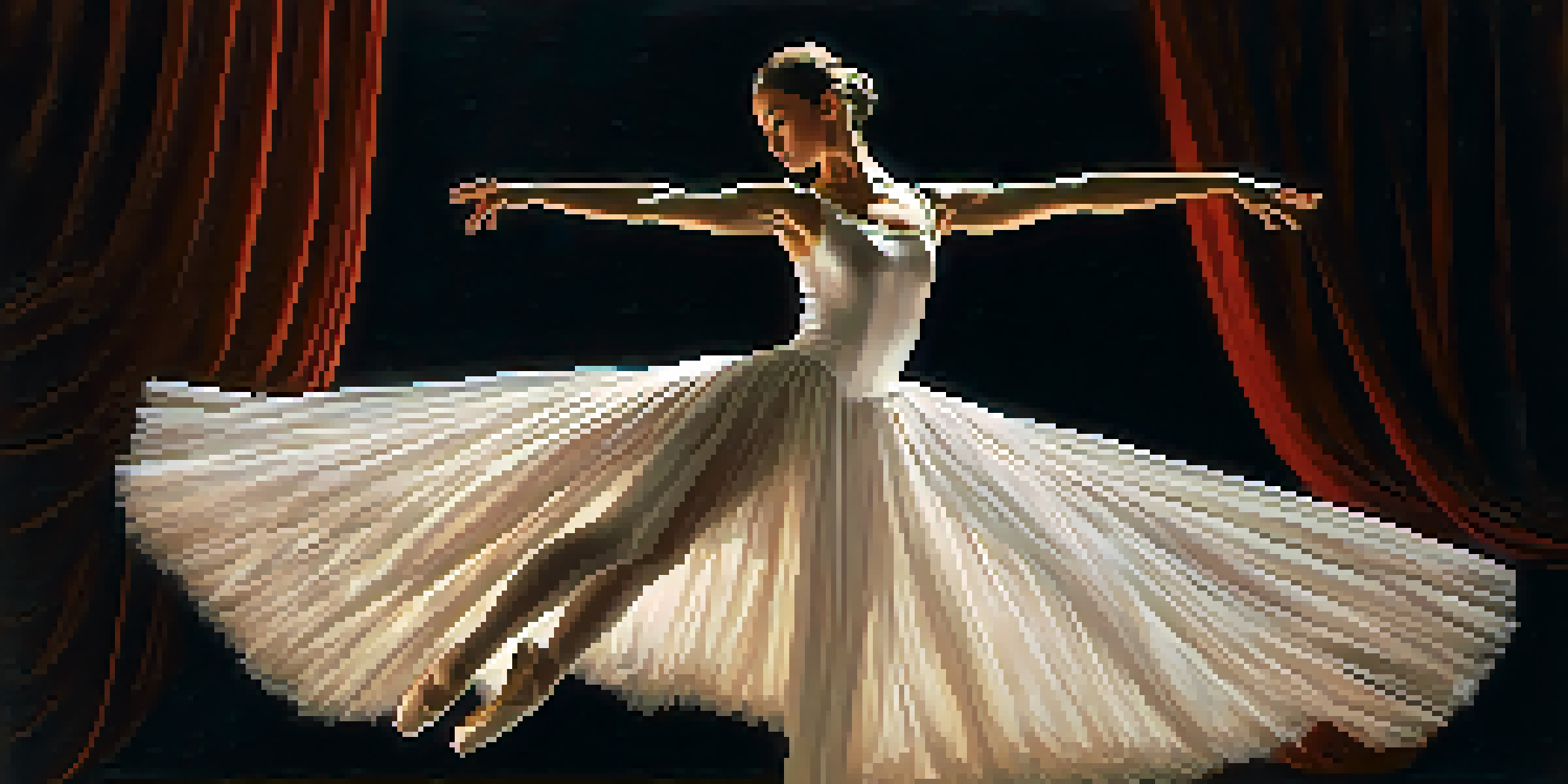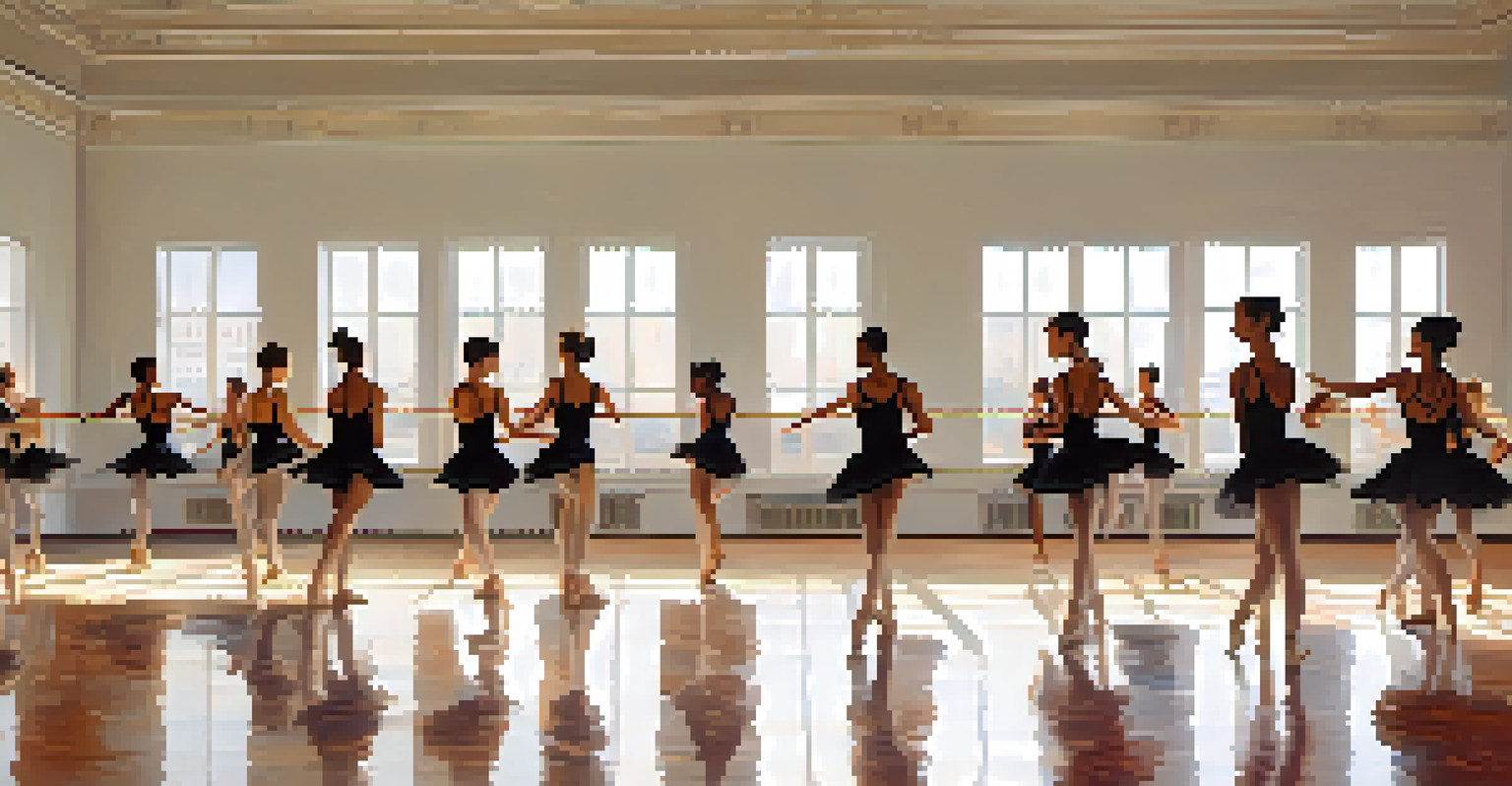The Impact of Performance Quality on Dance Technique Mastery

Understanding Performance Quality in Dance
Performance quality in dance refers to the expressiveness and execution of movements that captivate an audience. It's about more than just hitting the right steps; it's the energy and emotion a dancer brings to their performance. A dancer who embodies performance quality can transform a technically perfect routine into an unforgettable experience.
Dance is the hidden language of the soul.
This concept is essential because it bridges the gap between technique and artistry. While mastering dance techniques is crucial, the ability to convey feelings and connect with an audience can elevate a performance from good to great. Think of it like a musician playing a beautiful piece; the notes may be perfect, but the passion behind them is what truly resonates.
Moreover, performance quality can significantly impact a dancer's confidence and stage presence. When dancers focus on expressing themselves rather than merely executing steps, they often feel more empowered and engaged during performances. This shift in mindset can lead to a more compelling delivery, showcasing the depth of their training.
The Relationship Between Technique and Performance Quality
Technique serves as the foundation upon which performance quality is built. Without a solid grasp of basic movements, a dancer may struggle to convey emotion effectively. For instance, a dancer executing a pirouette needs to master their balance and alignment to avoid distractions from the beauty of the turn.

When technique is honed, dancers can focus more on the expressive elements of performance. This allows them to experiment with dynamics, facial expressions, and audience interaction, enriching their overall presentation. It's much like a painter mastering brush strokes before diving into the emotional depth of a landscape.
Performance Quality Enhances Dance
Performance quality combines expressiveness and technique, transforming a routine into an unforgettable experience.
In essence, the better a dancer's technique, the more freedom they have to express themselves. This interplay between skill and artistry is what makes performances truly memorable, allowing dancers to shine both individually and as part of a larger ensemble.
How Performance Quality Enhances Learning
Focusing on performance quality can also enhance the learning process for dancers. When dancers are encouraged to express themselves, they become more invested in their practice, leading to increased motivation and creativity. This engagement can make the process of mastering complex techniques feel less daunting.
The only way to make sense out of change is to plunge into it, move with it, and join the dance.
For example, a student who performs with enthusiasm during class is likely to retain the choreography better than one who simply goes through the motions. This connection between performance and learning creates a positive feedback loop, where excitement fuels practice, and practice enhances performance quality.
Additionally, this focus on quality can foster a supportive and collaborative environment in dance classes. Dancers are more likely to share ideas and feedback, contributing to a richer learning experience for everyone involved. Ultimately, this approach nurtures not just skilled dancers, but also confident artists.
The Role of Feedback in Developing Performance Quality
Constructive feedback is vital for dancers seeking to improve their performance quality. Instructors can offer insights not only on technique but also on how to convey emotion and connect with the audience. This holistic approach helps dancers understand what elements of their performance resonate most.
Receiving feedback in a supportive environment can encourage dancers to take risks with their performances. When they feel safe to experiment, they are more likely to find their unique voice and style. This individuality is what ultimately makes performances stand out and leaves a lasting impression on audiences.
Technique Fuels Expressive Freedom
Mastering dance techniques allows performers to focus on emotional expression, enriching their overall presentation.
Moreover, peer feedback can also be incredibly valuable. Dancers often learn a lot from watching each other, picking up on nuances that may not be obvious at first glance. This collaborative spirit fosters a community where everyone can grow and thrive together.
Exploring Different Styles and Their Impact on Performance
Different dance styles require varying approaches to performance quality. For instance, a ballet dancer might focus on grace and precision, while a hip-hop dancer may prioritize energy and rhythm. Understanding these nuances helps dancers adapt their techniques to fit the demands of each genre.
By exploring various styles, dancers can also expand their performance toolkit. This exposure allows them to incorporate diverse elements into their dancing, enriching their overall artistry. It's akin to an actor studying different genres to enhance their versatility and depth in performance.
Ultimately, this exploration fosters a greater appreciation for the art of dance as a whole. Dancers who embrace various styles often find new ways to express themselves, enhancing their performance quality and mastery of technique.
Mindset and Its Influence on Performance Quality
A dancer's mindset plays a crucial role in how they approach both technique and performance quality. A positive, growth-oriented mindset encourages experimentation and resilience, leading to more vibrant performances. Conversely, a fixed mindset might hinder a dancer's ability to take risks and express themselves fully.
For example, dancers who view challenges as opportunities for growth are more likely to push their boundaries and explore new facets of their artistry. This shift in perspective can transform the way they approach each performance, leading to a deeper connection with their audience.
Mindset Influences Performance Quality
A positive mindset encourages risk-taking and authenticity, leading to more vibrant and engaging performances.
Moreover, mindfulness practices can help dancers stay present during performances, allowing them to connect authentically with their emotions. This presence not only enhances performance quality but also increases enjoyment, making each moment on stage a fulfilling experience.
The Importance of Regular Performance Opportunities
Regular performance opportunities are key to developing both technique and performance quality. Engaging with an audience can help dancers apply what they’ve learned in practice, solidifying their skills and enhancing their confidence. These moments serve as a testing ground for integrating technique with expressive elements.
Participating in performances, whether in competitions or local showcases, allows dancers to experience the thrill of live feedback. This immediate response from an audience can motivate dancers to refine their skills and enhance their delivery. Each performance becomes a learning experience, pushing them closer to mastery.

Additionally, frequent performances foster a sense of community among dancers. Sharing the stage with peers creates camaraderie and encourages collaboration, further enriching their artistic journey. This supportive atmosphere can be invaluable for growth and self-discovery as artists.